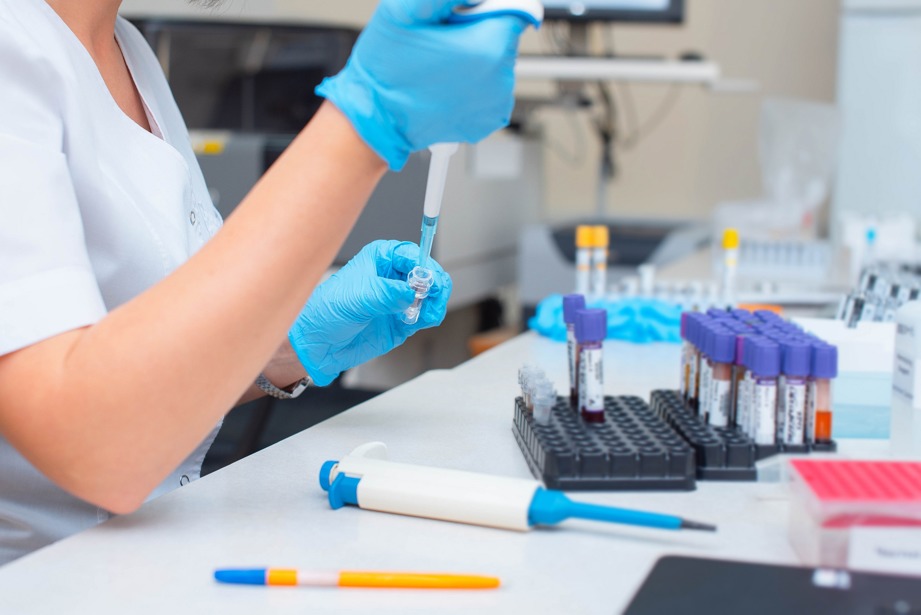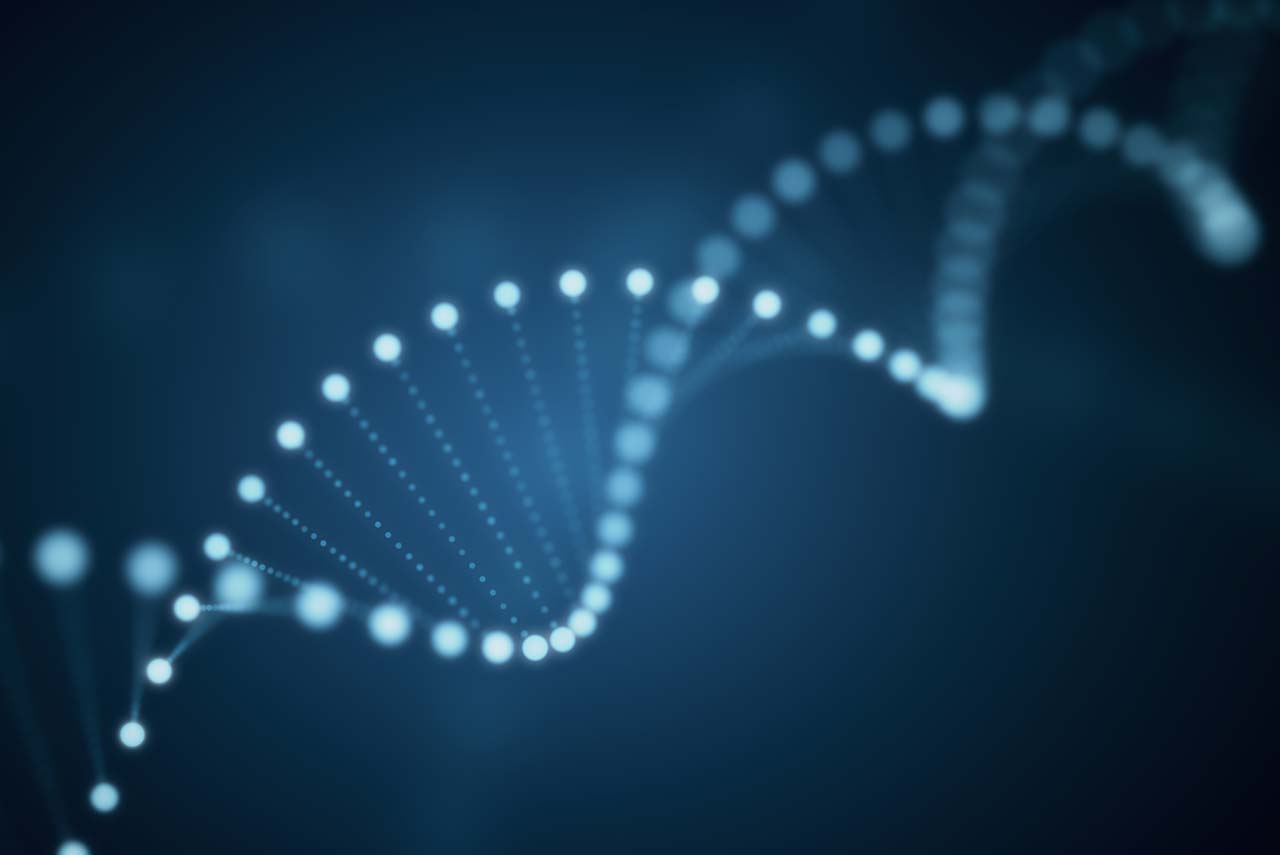What is genetic sequencing?
Genetic sequencing makes it possible to compare a patient’s DNA (a succession of nucleotides (Adenine, Thymine, Cytosine, Guanine)) with a “standard” reference DNA sequence to detect mutations.
Developed for the first time in the 1970s by Walter Gilbert and Frederic Sanger, genetic sequencing techniques have constantly progressed since then, making it possible today to sequence an entire human genome in one day. This tremendous progress is largely due to advances in computer technology and miniaturization, which took over from manual techniques in the 2000s. Today, next generation sequencing techniques, or NGS, enable the sequencing and comparison of millions of small DNA fragments simultaneously, thanks to nanotechnology, while it took 5 days to sequence 800 nucleotides in 1970.
Together with the increase in the number of nucleotides sequenced, the price of a genetic test has drastically decreased, from about 3 billion euros for the sequencing of a whole genome in 2003, to less than a thousand euros today.
What are the opportunities for patients ?
The next generation sequencing techniques (NGS) open an unprecedented field of opportunities for many rare genetic diseases and cancers, in two areas: diagnosis and pharmacogenetics.
New genetic sequencing techniques for the diagnosis of rare genetic diseases and cancers
As far as diagnosis is concerned, NGS tests offer a broader test spectrum, making it possible to scan a greater number of genes at the same time, and to raise diagnostic hypotheses that were not initially considered (because of an atypical clinical picture, for example).
This would drastically reduce the diagnostic wandering of patients, especially for those with an atypical or systemic clinical profile, who sometimes have to wait years and even decades before getting the right diagnosis. Indeed, in the ERRADIAG survey, conducted by the Rare Diseases Alliance (February 2016), 34% of respondents knew the name of their disease in less than 6 months, but 22% had waited more than five years [1].
This diagnostic errancy not only has serious psychological consequences for the patient and his or her family, but can also lead to a delay in the implementation of appropriate care, or even in the initiation of treatment when a treatment exists.
New genetic sequencing techniques for pharmacogenetics
Regarding patient management, NGS genetic tests are the gateway to the development of pharmacogenetics, defined by the European Medicine Agency (EMEA) as “the influence of interindividual variations in DNA sequence on the response to the effect of drugs” with the aim of personalizing a patient’s treatment.
This personalized medicine is already being developed in oncology, where the study of somatic/acquired (tumor-related) genetic characteristics allows targeted therapy treatments to be tailored to each patient’s phenotype and cellular profile. The goal is to maximize treatment efficacy and minimize potential side effects.
What are the stakes associated with the use of NGS tests?
The 3 major issues related to the use of NGS tests are access to these genetic tests, the study of our genome, and the data management of the results.
Patient access to NGS tests
Patient access to NGS tests depends on two key factors: prescription by geneticists or specialists, and availability of such tests.
On the prescription side, diagnostic difficulties are a first obstacle, especially in the case of rare diseases. Thus, among the points of difficulty in the diagnostic pathway identified in the UNIR White Paper (2018) [2], we find the lack of a culture of doubt (difficulty in recognizing specific clinical signs of rare diseases, lack of vigilance in the face of atypical situations, cognitive biases in medical practice, silo organization of expert opinions). However, it is clear that beyond the questions of genetic skills or awareness of health professionals, the complexity of the regulatory and administrative framework, as well as the opacity of the network of analysis laboratories are real burdens for prescribers. For example, the panels of tests available and the procedures for sending a sample ( required blood dose, format of the patient consent form, etc.) depend on each center and this information is not centralized.
Secondly, the availability of genetic tests in terms of territorial coverage remains heterogeneous: even if there are a large number of genetic analysis laboratories, not all of them have the same level of technical equipment (genetic sequencers), or the same level of skills and experience of their biologists. Consequently, not all French laboratories have access to NGS tests, and some laboratories specialize in specific rare diseases (e.g. cystic fibrosis in Brest, developmental anomalies in Rennes, etc.), which leads to incompressible delays in analysis that can sometimes exceed 6 months.
The study of the human genome
The other major challenge to overcome is the knowledge of our genome and the interactions between genetic and phenotypic variations. To date, there are 3,200 genes identified as responsible for the 6,000 to 8,000 known rare diseases [3], out of the 20,000 genes coding for proteins [4]. And this is without mentioning the non-coding genes, whose number is not fixed, as they are so numerous, which could have a role to play in genetic variations.
Moreover, beyond the identification of the genes responsible for a disease, the notion of predisposition factors adds an additional level of difficulty because it implies that not all identified genetic mutations necessarily lead to the same phenotypic expression and therefore the same pathology. For example, for a woman carrying a BRCA1 or BRCA2 mutation, the risk of breast cancer varies from 40% to 80% over the course of her life, depending on the studies, the type of gene involved, the family history of breast cancer, and her age [5]: this is a genetic predisposition, which therefore remains uncertain.
Management of the data generated by the results
The data management of the test results raises two issues: the support of the patient (especially on a psychological level) and the ethical issue of the use and storage of the data.
Indeed, the discovery and announcement of a genetic mutation, and even more so of a predisposition factor (when regulations allow it), raises the question of the support of patients following their diagnosis. Indeed, the announcement of the result of a genetic test is heavy with consequences, notably psychological and family related, and all the more so when there is still some uncertainty. Despite the efforts made to enable patient’s access to complete and personalized support (administrative, psychological, etc.), with the creation in 2004 of the dedicated function of “genetic counselor”, this remains a subject today. Not to mention the road that remains to be traveled before reaching a homogeneous deployment throughout the territory.
Another way of managing the uncertainty inherent in genetic testing would be to reduce it to zero by using the data from NGS tests to make large-scale comparisons. This is what some companies are trying to do today, such as Gene DX (an American company), which promises “highly accurate test results that make definitive diagnoses possible, even for complex cases”, thanks to its software and database. The company’s software and in-house database of over one million sequenced samples make it possible to make definitive diagnoses. However, the use and sharing of individual genetic data raises major questions of ethics and data protection, both nationally and internationally.
In conclusion, NGS techniques raise fundamental questions concerning ethics, health professionals’ training, development of skills and materials, but also the knowledge of our own genome. The advances in genetics made possible by NGS tests therefore call for reflection and reorganization at the local, national and even international levels, to allow access to innovation for patients and to define an appropriate ethical framework. In order to capture the full potential of NGS technology, it is necessary to carry out a joint reflection involving public institutions, learned societies, patient associations and also pharmaceutical companies.
About the author,
Romane, Consultant in Alcimed’s Healthcare team in France
[1] ERRADIAG, 2016, p.35. [2] Sanofi-Genzyme and Orange Healthcare. [3] White Paper UNIR, redacted by Sanofi-Genzyme and Orange Healthcare (2018). [4] https://www.science-et-vie.com/corps-et-sante/20-000-40-000-100-000-mais-combien-avons-nous-de-genes-46459. [5] https://www.e-cancer.fr/Patients-et-proches/Les-cancers/Cancer-du-sein/Facteurs-de-risque/Predispositions-genetiques



